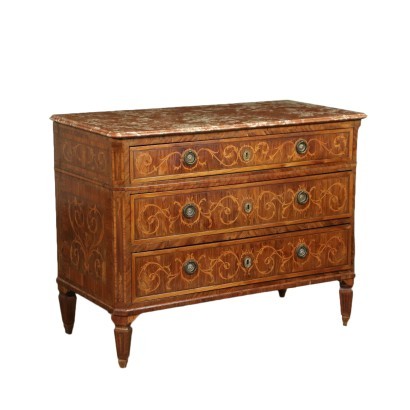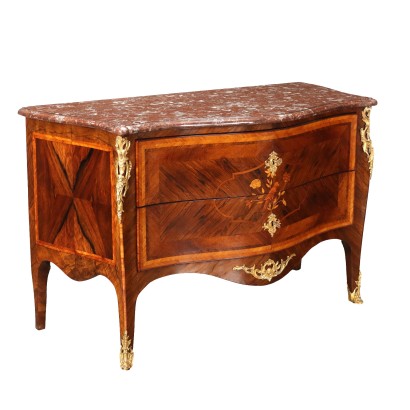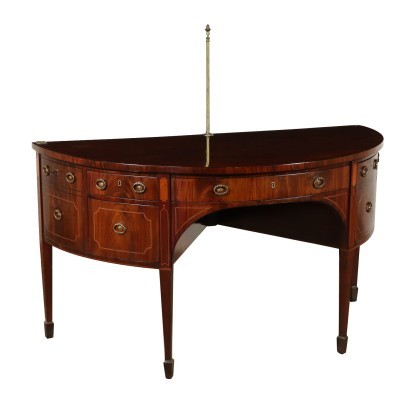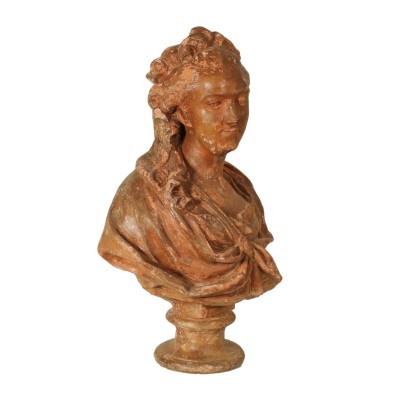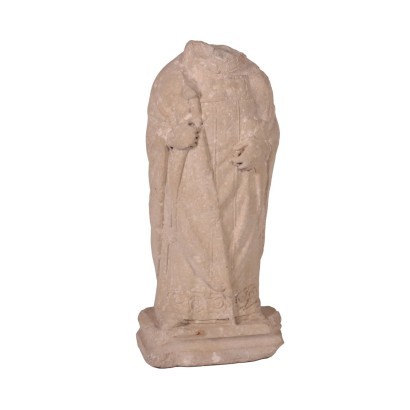Chest Of Drawers Neoclassical Bois De Violette Marble Italy Late '700
Features
Style: Neo-Classical (1765-1790)
Age: 18th Century / 1701 - 1800
Origin: Piemonte, Italy
Main essence: Brazilian Rosewood , Tulipwood , Boxwood , Cedar , Cherry , Olive
Material: Marble
Description
Neoclassical chest of drawers from Piedmont, supported by truncated pyramidal feet, connected to the lower band with an inlaid shelf, the front ones are at 45 degrees, like the uprights; there are three drawers on the front. Bois de violette veneer, threads in bois de rose, olive tree and cedar, entirely inlaid with phytomorphic motifs, both on the front and the boxwood sides; the feet are inlaid as well. The interiors are in poplar and fir, the marble top underwent an antique restoration.
Product Condition:
Fair condition. Wear consistent with age and use. Any damage or loss is displayed as completely as possible in the pictures. Product with a Certificate of Authenticity and Lawful Origin.
Dimensions (cm):
Height: 91,5
Width: 117
Depth: 59
Certificate issued by: Enrico Sala
Additional Information
Style: Neo-Classical (1765-1790)
This historical period includes a first phase that can be properly defined as the Louis XVI style.nOnly at a later time, with the maturation of archaeological fashions, was a new vision of furnishing civilization formulated and codified, now fully attributable to the Neoclassical Style.
In fact, both trends coexisted in unison until the last years of the eighteenth century.
nIn the field of cabinet making, the Directoire, Retour d'Egypte, Consular and Empire styles also fall within the neoclassical era.
nFind out more about Neoclassicism with the insights from our blog...
n
Age: 18th Century / 1701 - 1800
18th Century / 1701 - 1800Main essence:
Brazilian Rosewood
It is a hard, light blond wood, but with strong red and pinkish veins, which is obtained from tropical trees similar to rosewood. Its veins are reminiscent of striped tulips, which is why it is called tulipwood in English-speaking areas. It is used for inlays, often combined with bois de violette. In the 1700s and 1800s it was highly appreciated and used in France and England for precious veneers. It gives off scent for decades if not centuries after curing.Tulipwood
Obtained from some types of acacia, it is a hard essence, with purplish-colored veins, used in the inlays, in which, alongside the bois de rose, it generates beautiful contrasts. Also useful for making bronze accessories stand out.Boxwood
With a yellowish color, it is a very compact and hard wood, of oriental origin, which is obtained from evergreen shrubs of the Buxaceae family. It is used for inlays and for all-round workings both as furniture finishes and as small objects and sculptures.Cedar
Coniferous wood, originally from Lebanon in its most widespread variant, was already used by the ancient Egyptians in the construction of boats and coffins. The biblical quotation that notes that Solomon's palace had 45 columns of cedar is significant. Light in color, with a beautiful reddish vein and a characteristic and appreciated fragrance, it was used by French cabinetmakers especially for inlays and also in the creation of small objects.Cherry
Obtained from prunus cerasus , a plant of oriental origin, it is a hard wood with a light and delicate color, with a reddish vein. Due to its diffusion and availability it was used in Europe in popular furniture. In cabinet making, in the seventeenth century, it was widely used in France and England for inlay work. In Italy it was very successful in Lucca. It was also very popular in the United States for the manufacture, from the late 1600s, of commonly used furniture.The dictionary of antiques: Eclecticism
Classic Monday: a sofa from the 1800s example of eclecticism



